(i) Arsenic Poisoning
Though true, but shocking that the underground water may turn into poison and the drinking water from the hand pump or tube well becomes the source of crippling disease and death. This is deliberate poisoning created by successive governments and multinational agencies, which invested quickly in new technologies to dug water and deeper into the ground. Then the water table started to fall.
Studies in the arsenic affected zone have shown that the concentration increases with depth reaching at peak around 100-125 feet down and gets reduced as it reaches to 400 feet. Groundwater arsenic contamination by arsenic was first reported in 1983 in West Bengal when 63 people were reported suffering from arsenic poisoning. In May 2000, nine district in West Bengal had arsenic levels in ground water above the permissible unit of World Health Organization (WHO). The maximum permissible limit for arsenic in drinking water is 0.05 milligram per litre (mg/l). In 77 percent samples the arsenic level was found to be higher than the permissible limit. Arsenic crisis or arsenic toxicity develops after two to five years of exposure to arsenic contaminated drinking water, depending on the amount of water, consumption and arsenic concentration in water. Initially the skin begins darken known as diffuse melanosis. This happens first in the palms. Diffuse melanosis leads to spotted melanosis, when darkened spots begins to appear on the chest, back, and limbs.
Keratosis is the middle stage of arsenicosis. The skin in portions becomes hard and fibrous, as if body has broken out into the hard boils or ulcers. Diffuse or nodular keratosis on the palm of the hand or sole of the foot is a sign of moderately severe toxicity. Rough dry skin, after with palpable nodules on hands feet and leg mean, severe toxicity. This can lead to the formation of gangrene and cancer.
Arsenic poisoning brings with it other complications; liver and spleen enlargements and cirrhosis of liver, cardiac failure, neuropathy affecting primary, sensory function, diabetes, goitre and skin cancer.
Women appears to be more prone to arsenic poisoning, for instance Renu of Aripara, North 24 Paragana became blind due to arsenicosis. Her two sons have left the village in search of safe water and livelihood. Another son and daughter- in- law live with her, because they suffer from arsenicosis. She has lost all hope. She is very cynical about any kind of arsenic mitrgation technology. Sumtaya in Gardmabi village in Murshidabad district has wound on her right tighs. The wounds bleed. Her problem worsens each passing day. Like her, Leaten is a widow in Nanda Block in Murshidabad. She has a cancerous wounds on her hand that is slowly spreading to the rest of her body. For her hospital is too far and too costly. She just waits for death.
Due to arsenicosis women are considered as mad. In Fakir para locality in Chanalti block in North 24 Paragrana, women suffering from arsenicosis have been abandoned by loved one.
Contamination of water by arsenic has spread to U.P and Bihar. Dinanath of Ekwana Rajpur village in Balia district, UP suffers from skin cancer. Two fingers of his eft hand had developed ulcers and had to be amputed. His two daughters died in last two years.
The lesions are an is escapable social stigma, especially for girls. No body wants to marry girls, because of the spots. Everybody has to parade half naked in front of the prospective groom’s family to prove that the entire village has the disease, we are not the only ones. People are finding difficult to find a match for their daughters. The economy of the arsenic affected village has stagnated. Arsenic has crippled the hands that could nurture the fertile land.
Every new survey shows that the arsenic trail is far from being completely known. It certainly seems to be creeping along the basins of rivers of Ganga and Brahamputra. The extent of arsenic contamination now includes several states in India. The recent studies prove the presence of the contaminant in several states: West Bengal, Bihar, Assam, Uttar Pradesh, Chhatisgarh and Jharkhand.
In Ekwana Rajpur village of Balia district, water is found to have 73 parts per billion ( ppb) while the limit is only 10 ppb, more than 7 times of the prescribed limit. In Rajnandan gaon district in Chattisgarh, about 8% samples had arsenic above 50 ppb, 5 times higher than the standard limit. In Bhojpur district of Bihar more than 57% people in a village are drinking water which has arsenic concentration above 50 ppb, scenario is equally bad in Buxar. The menace has also spread to Jharkhand, where in Sahibganj district, 30% samples had arsenic above 10ppb, 19 % above 50ppb and 26% above 100 ppb. The studies show that the area near Ganga is prone to arsenic poisoning.
The arsenic crisis is the direct fall out of a public health imperatives. When policy makers found surface water bodies caused massive outbreaks of water borne diseases, instead of tackling contamination they pushed people towards ground water. Surface water bodies fell into greater neglect as hand pumps became the preferred option for drinking of water. Now, we have come full cycle, hand pumps (India mark) are the problem and the solution lies in going back to surface water bodies.
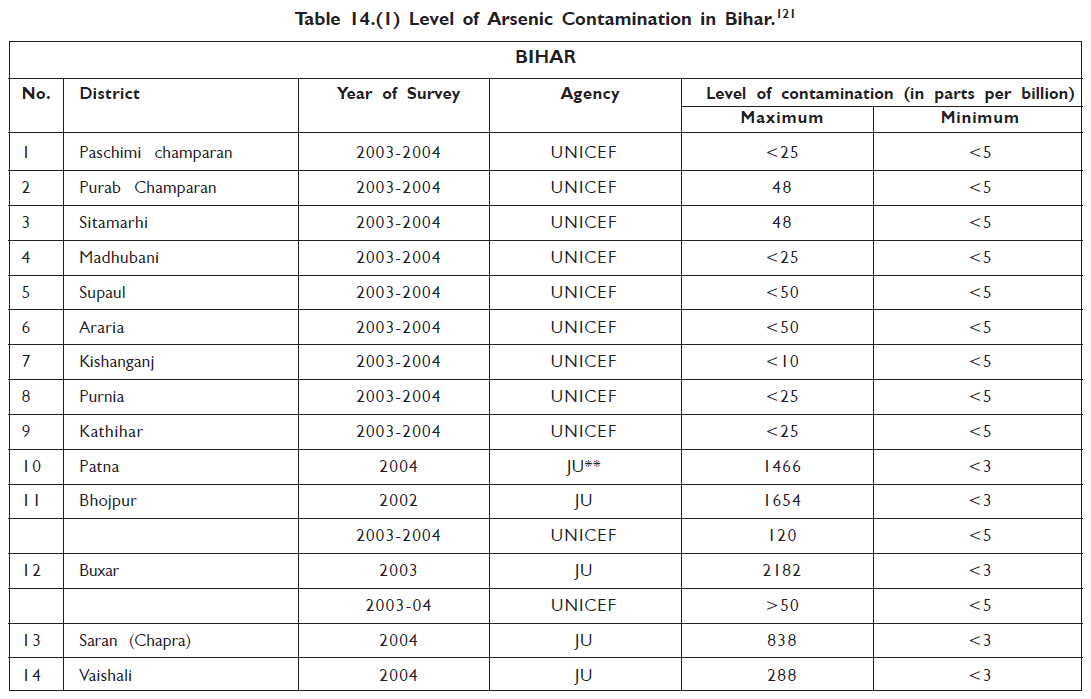
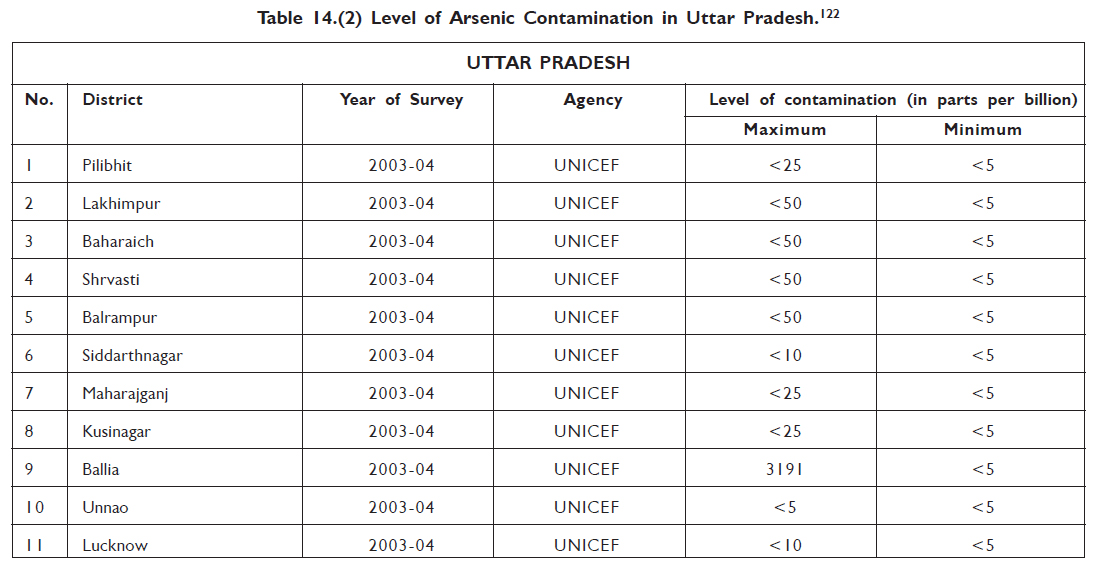
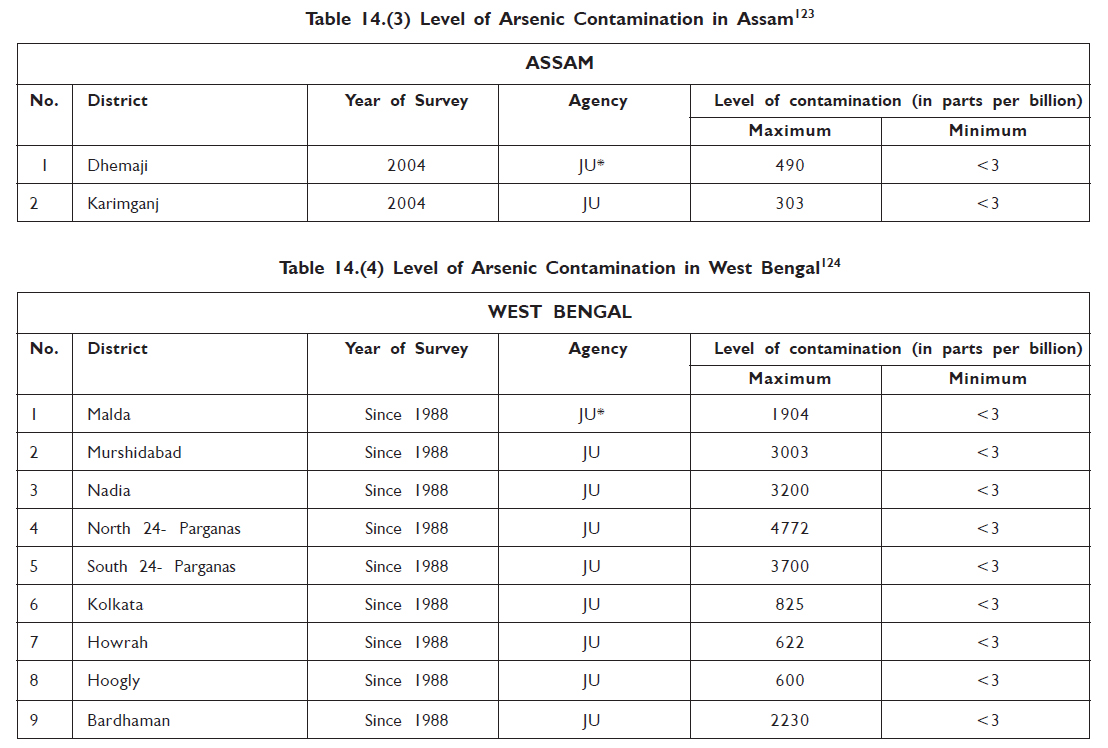
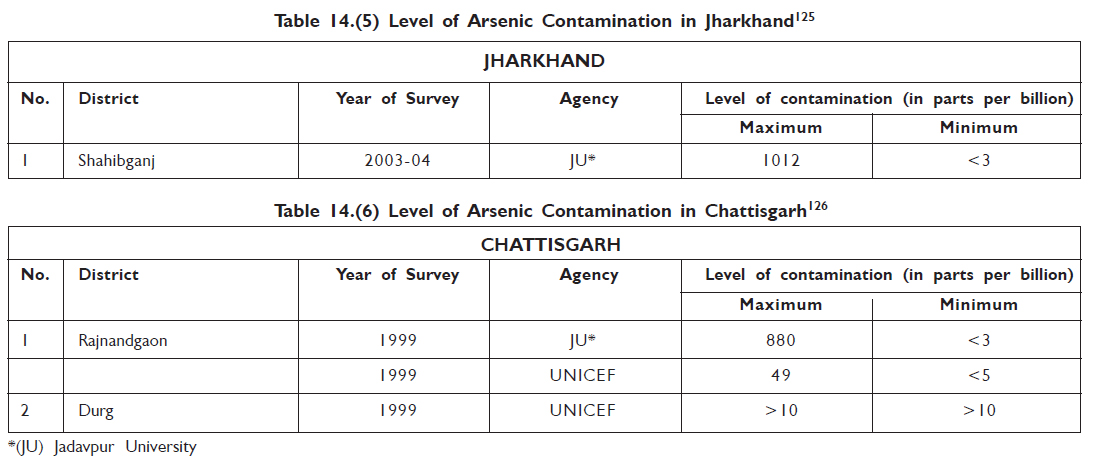 But this poison is not as deadly as the callousness of the government, which neglects the disease. When the government denies the existence of the problem, the poison will spread. That is what we really need to worry about. According to an environmentalist, arsenic poisoning is the biggest instance of toxicity. The magnitude and the extent of the problem is still unfolding. The problem gets more serious as there is no medicine The only medicine is safe drinking water and nutritious food. Skin lesions are mere manifestations, whereas arsenic poisoning actually devastates victims internally.
But this poison is not as deadly as the callousness of the government, which neglects the disease. When the government denies the existence of the problem, the poison will spread. That is what we really need to worry about. According to an environmentalist, arsenic poisoning is the biggest instance of toxicity. The magnitude and the extent of the problem is still unfolding. The problem gets more serious as there is no medicine The only medicine is safe drinking water and nutritious food. Skin lesions are mere manifestations, whereas arsenic poisoning actually devastates victims internally.(ii) Fluoride Poisoning
Fluorosis is another crippling and painful disease caused due to excess intake of fluoride through water. Fluorine and Fluoride compounds are listed by U.S. Agency for Toxic substance and disease registry as one of the top 20 among 275 substances that pose the most significant threat to the human health. There is no treatment for fluoride related human disorders. Safety lies only in the prevention.
In India, Fluorosis has spread over 19 states. According to a study by WHO nearly 66 million i.e about 9.4% of the total rural population are in the grip of fluorosis. Though the prescribed limit of fluoride is 1.5 mgl, but fluoride level is as high as 48 mgl have been reported.
The states where the ground water is contaminated include Andhra pradesh, Rajasthan, West Bengal, Uttar Pradesh, Maharashtra, Karnatka, Chandigarh, Punjab, Haryana, Delhi, Orissa, Tamil Naidu, Gujrat, Kerala, Madhya Pradesh, Jammu and Kashmir, Himachal Pradesh and North Eastern Region. Hundreds of villages on the southern bank of Brahamputra in Assam are afflicted by the contamination. 70% of the Assamese population suffering from fluorosis are from Karbi Anaglong where in 1999, the fluoride level was reported as high as 5- 23mgl.
Till recently, West Bengal was not in the list of affected of states by Fluorosis. Now ground water in large areas of Birbhum viz Nalhati, Suri, Rampurhat, Bhabhranandpuri, Dubragpur, Sainthi and Raj Nagar contain fluoride much beyond the prescribed limit. In some places at Nalhati, the fluoride concentration is found to be 15-19 mgl almost 15-20 times higher than the safe limit prescribed by WHO.
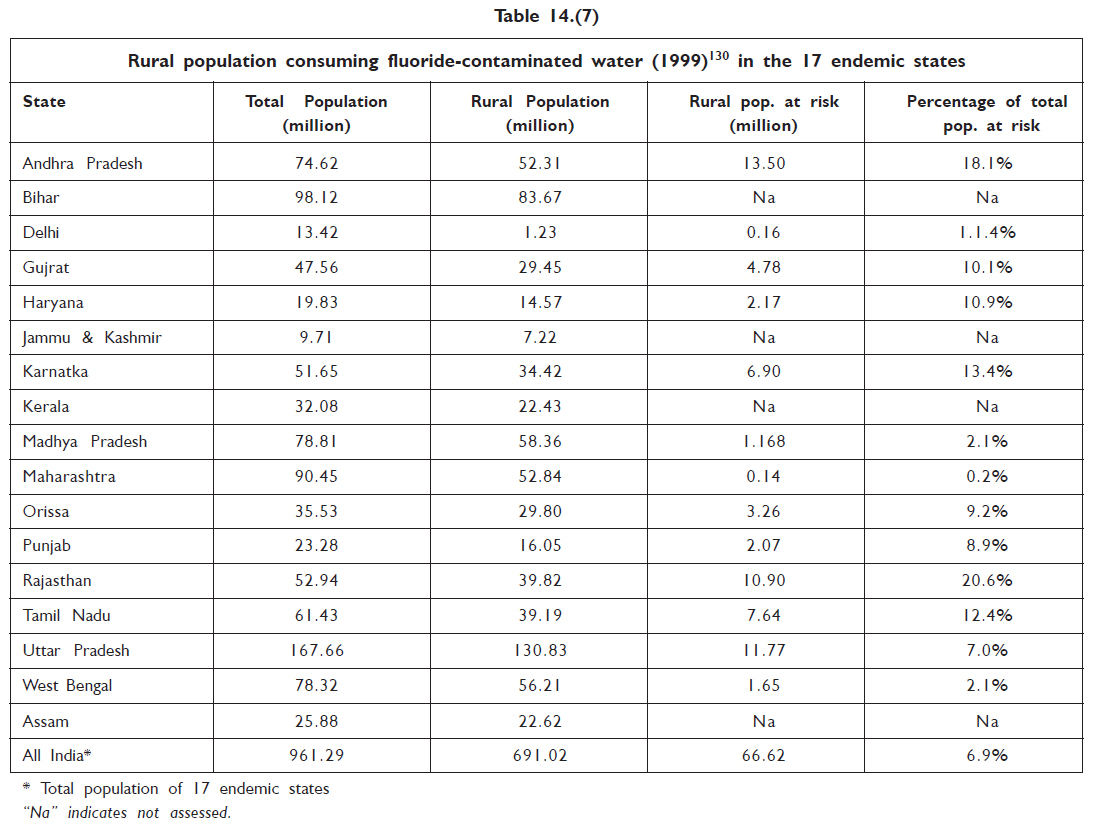 Fluorosis is a disease that neither allows a person to live nor to die. In Liliya block of Amreli district in Gujrat, people hang ropes from the ceiling of rooms and toilets to stand up. In Haripur village of the block, about 70% are suffering from fluorosis (known as “Wah” in Gujrati). In the morning, the knees are swelled and people have to wait for one hour before they can move. Such affliction brings life to a stand still. The daily routine becomes the bizarre experience.
Fluorosis is a disease that neither allows a person to live nor to die. In Liliya block of Amreli district in Gujrat, people hang ropes from the ceiling of rooms and toilets to stand up. In Haripur village of the block, about 70% are suffering from fluorosis (known as “Wah” in Gujrati). In the morning, the knees are swelled and people have to wait for one hour before they can move. Such affliction brings life to a stand still. The daily routine becomes the bizarre experience. All the 32 districts of Rajasthan are affected with the problem of fluorosis, in which Nagaur, Bhilwara Ajmer, Pali, Jalore, Barmer and Charu are the worst affected districts. Nearly 56 percent of villages in the state are affected with the major health hazard and over 25 percent rural population is affected with deformities. The problem has its socio-psychic effects too. Parents of girls are worried about their marriages as even if they manage to get their daughters married after hiding the shocking facts of the region, then there are chances that the girls are treated badly by the boy’s family. There are instances of break up in marriage alliances between families where daughters or sons suffer from fluorosis.
Such affliction also sunders livelihood. In Bakhari village in Jharkhand’s Daltongunj district, almost two thirds population has developed physical deformities due to fluoride contamination of water. This is affecting the main occupation i.e agriculture, as there are fewer hands to till the soil. Fluoride rich water is bad for land and crops. A decade ago, in Gujarata’s Amreli district, one hectare of land produced 100 kg , today it produces only 4 kg. Even the wheat grown with fluoride –laced water tastes bad. No one buys cattle from the fluoride affected villages.
The presence of fluoride in ground water and soil is human made. We have over extracted ground water and have tapped aquifers with high fluoride concentration. Over exploitation of ground water in last 20 years is the chief reason for the spread of fluorosis in the states like Gujrat and Punjab. With the coming up of diesel pumpsets, farmers started to dig deeper into the earth’s crust and are extracting poison. Falling water table also increasing the fluoride content in the water. Income places water table is decreasing one and three metres per year.
Excessive fluoride can also damage a foetus, if the mother is exposed to high doses of fluoride during pregnancy or during breast-feeding. The infant may die due to calcification of blood vessels. Abortion, still births and deformities associated with fluorosis are also known. Male infertility associated with an abnormality in sperm morphology and development of early cataract has been blamed on fluoride toxicity.
(iii) Pesticides Worst Pollutant:
According to experts, pesticides are the most difficult to remove from water. Pesticides enter surface and groundwater as runoff from crops and they even pollute fresh water bodies like rivers, lakes and estuaries. Incidentally, Delhi uses as much as 62 metric tonnes of pesticides while farmers in UP and Haryana use 7569 metric tonnes and 5025 metric tonnes annually. The rivers Yamuna and Ganga flowing through this region are already carrying huge amounts of pesticides when they enter Delhi. The DJB, infact, does not have the sophisticated equipment needed to remove pesticide residue from water.
Cancer, liver and kidney damage, neurological and reproductive disorders are just a few of fatal and chronic health condition one can end up from prolonged consumption of such contaminated water. The most alarming fact about pesticide and effluent pollution of water is that young children are more sensitive to the effects of toxic chemicals because they eat and drink more per body weight and have faster metabolism than adults. Most people are said to receive up to 12 percent of their lifetime dose of toxic chemicals in the first year of their life.
A huge proportion of the rural population suffers due to chloride, zinc, nitrate and sulphide pollution. The gravity of the problem can be understood from the fact that nitrate is present in 68 districts of 12 states, chloride in 17 districts of 5 states, sulphide in 3 districts of one state, iron in 26 districts of seven states, zinc in six districts of 3 states and chromium in one district of one state.
To add to the pesticide load in the water, there are industrial effluents being dumped into the river everyday. There are paper and sugar industries and distilleries besides glass, nickel and chromium plants, along the river all-contributing to the pollution of the river.
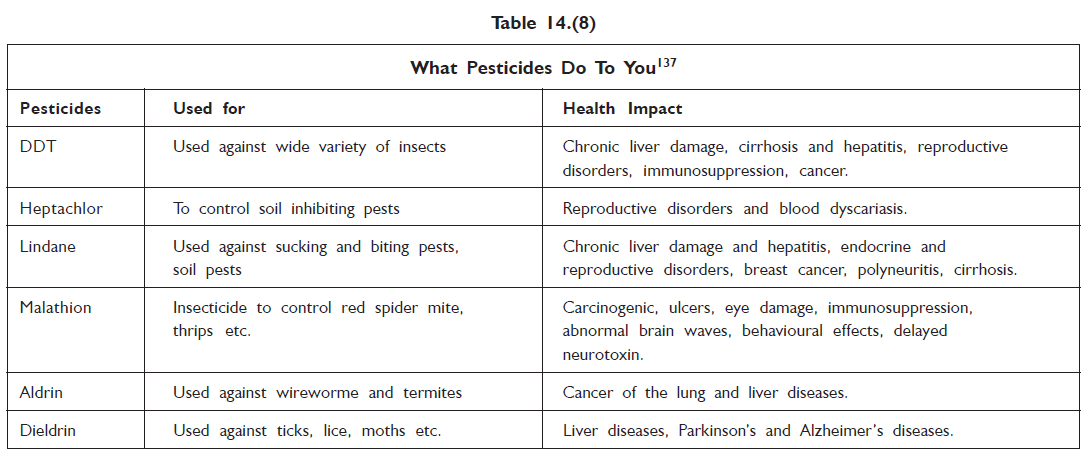
Path Alias
/articles/water-pollution-arsenic-fluoride-pesticides
Post By: Hindi